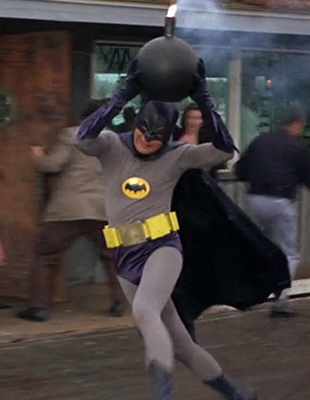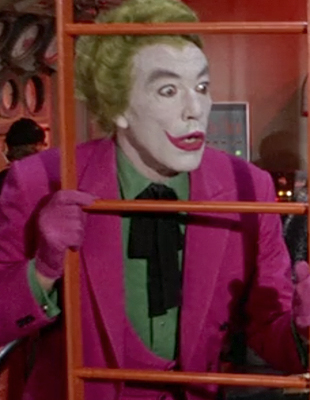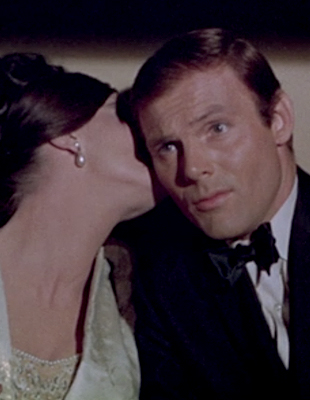TAGGED AS: DC Comics, Superheroes

DC’s Batman Vs. Superman: Dawn Of Justice and Suicide Squad weren’t received as disappointments so much as they were greeted as unforgivable insults to the general public. They inspired a lot of wailing, complaining, rending of garments, and insane over-reactions.
A moviegoing audience pathologically obsessed with superheroes responded to these movies with a world-wide gasp of shock and disappointment. It was as if they imagined that if they just tried hard enough, they could will different, better versions of Batman Vs. Superman: Dawn Of Justice and Suicide Squad into existence, and then they wouldn’t have to feel silly about being so emotionally invested in the box office and critical consensus of movies about weirdos in crazy costumes.
One segment of the public began weeping uncontrollably while screeching, “No! A silly superhero/super-villain team-up movie I was looking forward to wasn’t as good as I thought it could/should/would be! We can’t let such an abomination stand. We demand justice! We demand revenge!” Another antithetical yet curiously similar group, meanwhile, hollered, “No! A silly superhero/super-villain team up movie isn’t being treated by critics with the hushed reverence it’s due! That’s not fair! We demand justice! We demand revenge!”
Yes, the strange, overheated overreaction to Batman Vs. Superman: Dawn Of Justice and Suicide Squad’s negative reviews is silly and ridiculous. But unlike the 1966 film version of Batman, it’s not silly and ridiculous in a fun, self-aware, campy fashion. No, the hallmark of these online complainers is that they take themselves way too seriously, whereas the defining feature of Adam West’s 1960s Batman is that it does not take itself seriously at all.
In its 1960s incarnation, Batman never stopped winking at audiences to let them know that it was in on the joke. The show and its spin-off movie reveled in artificiality. They set out to make a live-action superhero extravaganza that was more cartoonish than actual cartoons and more of a comic book than actual comic books.
 |
The 1960s Batman was as much a parody of its source material as a straight adaptation. |
Like the recent film versions of 21 Jump Street, the 1960s Batman was as much a parody of its source material as a straight adaptation. Unlike the Batman reboots that followed, the show and movies did not aim for realism or grit. The show didn’t just acknowledge the absurdity of a rich middle-aged man dressing up in a silly costume to fight evildoers in equally silly costumes, it ratcheted up that absurdity to delirious satirical levels.
I suspect the makers of the 1966 Batman film would have found the notion that subsequent filmmakers would treat the character as a tormented figure of infinite darkness who inhabits a gloomy world full of moral ambiguity both preposterous and a huge joke. As played by Adam West in the role that made him a trash-culture icon, Batman is less the living personification of the psychological costs of vengeance and humanity’s dark side than a clean-cut, wholesome do-gooder beloved by everybody other than the cartoonish criminals.
The 1966 Batman pits West’s Bruce Wayne/Batman and Burt Ward’s Dick Grayson/Robin against a felonious foursome of the TV show’s most popular and prolific villains. There’s Catwoman (Lee Meriwether, who is great but will never be able to compete with Eartha Kitt’s even greater interpretation of the role), a conniving super-villain who attempts to seduce Bruce Wayne in her alter-ego as a beautiful Russian. Batman may be the world’s greatest detective, but he’s somehow not sharp enough to figure out that his new Russian crush bears a distinct resemblance to one of his greatest (and certainly sexiest) foes.
Then there’s the gloriously redundant twosome of the Joker (Cesar Romero) and the Riddler (Frank Gorshin). True, jokes and riddles are different, but by including both of these gentlemen in the same story, it becomes clear that the show returned to the “mirthful supervillain” well at least once too often. The film clumsily and amusingly acknowledges this weird redundancy by having characters state repeatedly that Batman and Robin must wrestle with crazy hybrids like “a riddle in the form of a joke” as well as “joking riddles.” Finally, we have Burgess Meredith as the Penguin, who is old, short, and weak but smart enough to rent a submarine — where part of the film takes place — under the clever pseudonym P.N. Guin.
This not-so-fabulous foursome has joined forces to steal a miraculous invention able to “dehydrate” and then “re-hydrate” human beings. They plan to blackmail the nations of the world with this ridiculous contraption, which is really nothing more than a MacGuffin. But four villains means four times the frenzied over-acting. The Riddler, Penguin, and Joker all have a tendency to shout their comic book banter while mugging deliriously in ways that make them seem more hyper than scary. The four “super” villains here don’t seem capable of hurting Batman’s feelings, let alone cause him physical harm. By contrast, Nolan’s Batman films had terrifying villains: Scarecrow, the Joker, and Bane all seemed capable of killing Batman.
 |
The four “super” villains here don’t seem capable of hurting Batman’s feelings, let alone cause him physical harm. |
On television, Batman defined camp better than anyone this side of Susan Sontag. That extends to this faithful adaptation, but in addition to the film’s refreshing acknowledgment of its inherent ridiculousness, there are some sharp, memorable gags that score big laughs. Early in the film, for example, Batman and Robin are out in their Bat-Copter when Batman rappels down via rope ladder and spends what feels like a solid fifteen minutes engaged in a one-sided boxing match with a rubber shark so hilariously phony it suggests that “punching the shark” should join “jumping the shark” as a pop-culture cliche. One of the film’s other signature set-pieces finds Batman/Bruce Wayne desperate to get rid of a wonderfully fake-looking bomb but unable to find a place to toss it where it won’t cause major harm. An overwhelmed Batman then issues one of the film’s signature pieces of dialogue: “Some days you just can’t get rid of a bomb!”
Batman is also full of inspired running jokes, and one of my favorites is its obsession with sticking a “Bat” into the name of everything, even if it just makes things confusing. When preparing to battle the aforementioned pesky shark, for example, Batman makes sure to specifically request “shark-repellent bat-spray” from Robin. This is, of course, a shark repellent spray used by the Batman, but it’s confusingly worded enough that it sounds like it might be a shark repellent that also repels bats, or possibly Batman, or Batmen in general. Regardless, it’s all very silly.
In another standout scene that similarly belongs in an old Looney Tunes cartoon, Batman and Robin are scaling a wall — something they did all the time in the TV show, which frequently felt incredibly, deliberately fake — and Robin expresses shock and horror that some ne’er-do-wells drink so excessively they see things that aren’t there. Batman explains that they’re in a tough neighborhood full of “rumpots” and, as if on cue, one such rumpot pokes his head out his window just long enough to see what he naturally assumes is an alcohol-induced hallucination of a pair of men in outrageous tights scaling his building.
Batman is a product of the go-go mid-1960s. It’s got an unmistakable groovy bachelor pad vibe. West’s Batman is the only one who seems to prefer the millionaire bachelor side of his persona to the one who dresses up like an angel of vengeance to beat up bad guys. Christian Bale acted as if Bruce Wayne was in physical pain every time he was in a tuxedo at a fancy party, but West’s Batman seems like he could probably let go of the whole “crime fighting” thing without much concern. There are no stakes here, no real danger, just a bunch of silly heroes in Halloween costumes battling equally silly villains in Halloween costumes.
 |
West’s Batman is the only one who seems to prefer the millionaire bachelor side of his persona to the one who dresses up like an angel of vengeance. |
When Batman squares off against the film’s quartet of All-Star Super-Villains in an amusingly amateurish battle royale late in the film, it becomes apparent just how hilariously unthreatening his foes really are. The Joker, Riddler and Penguin all come off as frail men in their fifties who would probably lose a physical altercation with a toddler. They’re almost impressively unimpressive in their old, sad, weak physicality.
In an attempt to make it more of a fair fight, Catwoman tosses a cat to Batman, who then must physically battle his geriatric foes without dropping the cat. It’s a brilliant sight gag, and it’s also far more impressive than anything in Christopher Nolan’s Batman movies. Let’s see Christian Bale’s Batman spend five fighting minutes fighting Bane without dropping an enormous tabby.
I loved the Batman TV show as a kid, and I responded just as strongly to it as an adult. That’s because the show operates on multiple levels. The black and white morality, goofy banter, crazy sound effects rendered both visually and sonically, outsized villains, and cool gadgets all appeal to kids and emotionally stunted adults. But the film’s winking, ironic tone, self-reflectiveness, meta elements, and breezy, campy humor make it just as appealing to grown-ups.
While there’s no reason a trifle like this needs to be any longer than 85 minutes (it could stand to trim 20 minutes or so), Batman holds up surprisingly well as an entertaining, hilarious lark. It’s also a much different film than the Batman movies that would follow. True, Joel Schumacher tried to channel some of the show’s campy spirit with Batman Forever and Batman & Robin, but there’s a difference between being in on the joke, as West’s Batman clearly is, and being the joke itself, like Batman & Robin. The 1960s Batman was a smart, hip show playing at being silly and dumb, but Schumacher’s films are genuinely stupid.
Obviously, no one wants a return to the Schumacher era of Batman, but I think the gloomy Guses behind the new DC Universe films would be smart to take another look at this particular incarnation. There are elements of it DC might want to consider employing in subsequent films involving Bruce Wayne and his costumed alter-ego, such as being “fun” and “enjoyable” rather than a dreary, mournful slog.
Original Certification: N/A
Tomatometer: 80 percent
Re-Certification: Fresh
Nathan Rabin if a freelance writer, columnist, the first head writer of The A.V. Club and the author of four books, most recently Weird Al: The Book (with “Weird Al” Yankovic) and You Don’t Know Me But You Don’t Like Me.
Follow Nathan on Twitter: @NathanRabin